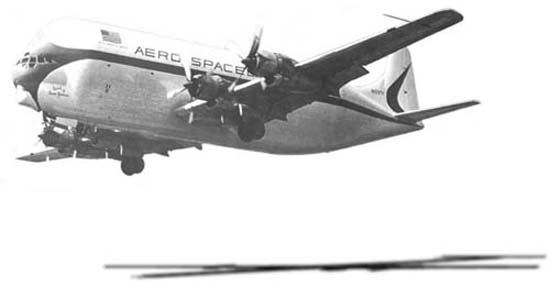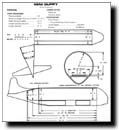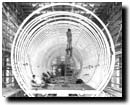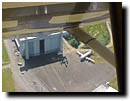
Drawings
 The 377MG Mini-Guppy was the first of the new generation of Guppys
that was built using an entirely new fuselage to connect the existing Stratocruiser
sections. Gone was the modified Stratocruiser's limitation of an 8 ft. wide
floor. By designing a new fuselage, ASI was able to create the first "wide-body"
Guppy, with a 13 ft. wide cargo floor and a maximum inside diameter of 18
ft. with the constant section measuring just over 73 ft. long.
The 377MG Mini-Guppy was the first of the new generation of Guppys
that was built using an entirely new fuselage to connect the existing Stratocruiser
sections. Gone was the modified Stratocruiser's limitation of an 8 ft. wide
floor. By designing a new fuselage, ASI was able to create the first "wide-body"
Guppy, with a 13 ft. wide cargo floor and a maximum inside diameter of 18
ft. with the constant section measuring just over 73 ft. long.(43K JPG image)
 Engineers at Aero Spacelines retained the C-97's original powerplants,
the Pratt & Whitney R-4360 Wasp Majors. The Mini-Guppy's empty weight is
85,000 lbs. carrying a maximum payload of 41,120 lbs. (strange number-DS),
making the maximum take-off gross weight of 147,000 lbs while having a maximum
landing weight of 130,000 lbs. The 377MG's wingspan is 156 ft. 3 in. and
is 132 ft. 10 in. long. The fuselage is over 27 ft. high and the tail is
a bit more than 38 ft. tall.
Engineers at Aero Spacelines retained the C-97's original powerplants,
the Pratt & Whitney R-4360 Wasp Majors. The Mini-Guppy's empty weight is
85,000 lbs. carrying a maximum payload of 41,120 lbs. (strange number-DS),
making the maximum take-off gross weight of 147,000 lbs while having a maximum
landing weight of 130,000 lbs. The 377MG's wingspan is 156 ft. 3 in. and
is 132 ft. 10 in. long. The fuselage is over 27 ft. high and the tail is
a bit more than 38 ft. tall. (32K JPG image)
Pictures
 The Aero Spacelines 377MG Mini-Guppy began life as Boeing B-377
N1037V (c/n 15967), and delivered as Pan American Airways Clipper Fleetwings
N1037V. Pan American took delivery September 8, 1949. It was traded back
to Boeing in 1960, sold to Mansdorf, then to Aero Spacelines in 1963. After
the purchase by Unexcelled, Inc. Aero Spacelines moved it's base of operations
to Santa Barbara, California.
The Aero Spacelines 377MG Mini-Guppy began life as Boeing B-377
N1037V (c/n 15967), and delivered as Pan American Airways Clipper Fleetwings
N1037V. Pan American took delivery September 8, 1949. It was traded back
to Boeing in 1960, sold to Mansdorf, then to Aero Spacelines in 1963. After
the purchase by Unexcelled, Inc. Aero Spacelines moved it's base of operations
to Santa Barbara, California. (18K JPG image)
 This is a reprint of an article Mini Guppy Begins Certification
Testing written by George S. Hunter which appeared in the July 3, 1967
issue of AVIATION WEEK & SPACE TECHNOLOGY. It's got good technical details
on the Mini Guppy with many new pictures not seen in over 30 years!
This is a reprint of an article Mini Guppy Begins Certification
Testing written by George S. Hunter which appeared in the July 3, 1967
issue of AVIATION WEEK & SPACE TECHNOLOGY. It's got good technical details
on the Mini Guppy with many new pictures not seen in over 30 years! (Click on the imagel to read the article Mini Guppy Begins Certification Testing )
 Aero Spacelines converted the N1037V into the Mini-Guppy using
parts from B-377 ( c/n 15967). Seen in this picture, the belly pan and cockpit
section is about all that remains of the original C-97 fuselage which has
also been stretched at this point. The final piece of the upper fuselage
has been cut away, and is being lifted out of the way. Note in this picture
the method of jigging the fuselage, accurate but simple.
Aero Spacelines converted the N1037V into the Mini-Guppy using
parts from B-377 ( c/n 15967). Seen in this picture, the belly pan and cockpit
section is about all that remains of the original C-97 fuselage which has
also been stretched at this point. The final piece of the upper fuselage
has been cut away, and is being lifted out of the way. Note in this picture
the method of jigging the fuselage, accurate but simple. (31K JPG image)
 The bulkheads and new floor are being framed up in this picture.
The jig for aligning the tail is as basic as the rest of the methods used
by ASI. This is a very graphic example of how the second generation of Guppys
were built. Notice the temporary shelter erected around the fuselage giving
modest protection from the elements.
The bulkheads and new floor are being framed up in this picture.
The jig for aligning the tail is as basic as the rest of the methods used
by ASI. This is a very graphic example of how the second generation of Guppys
were built. Notice the temporary shelter erected around the fuselage giving
modest protection from the elements. (46K JPG image)
 Seen here during construction of the fuselage. Note the use of
rope and C-clamps to hold the bulkheads in alignment prior to attaching
the stringers.
Seen here during construction of the fuselage. Note the use of
rope and C-clamps to hold the bulkheads in alignment prior to attaching
the stringers. (84K JPG image)
 The Mini-Guppy is seen here being towed to the paint shop for
the application of the final paint job on the last sections of bare fuselage.
The Mini-Guppy is seen here being towed to the paint shop for
the application of the final paint job on the last sections of bare fuselage.
(27K JPG image)
 The first flight as 377MG Mini-Guppy N1037V, christened "Spirit
of Santa Barbara", was on May 24, 1967. This Guppy featured a swing tail
for loading cargo.
The first flight as 377MG Mini-Guppy N1037V, christened "Spirit
of Santa Barbara", was on May 24, 1967. This Guppy featured a swing tail
for loading cargo. (18K JPG image)
 Only two days later on May 26, the Mini-Guppy was used for it's
first cargo flight, flying a Budd Company Skylounge across the Atlantic
to the 1967 Paris Airshow. While in France, the Mini-Guppy was flown south
to Toulouse for a demonstration for Aerospatiale officials who were considering
using this type of an aircraft in the future production of planned airliners.
Only two days later on May 26, the Mini-Guppy was used for it's
first cargo flight, flying a Budd Company Skylounge across the Atlantic
to the 1967 Paris Airshow. While in France, the Mini-Guppy was flown south
to Toulouse for a demonstration for Aerospatiale officials who were considering
using this type of an aircraft in the future production of planned airliners.
(14K JPG image)
 Although the 377MG's interior dimensions at 14 ft. high and 18
ft. wide made the Mini-Guppy too small for Aerospatiale to use, the demonstration
did set some minds to thinking about the possibilities of using this type
of transport in the future.
Although the 377MG's interior dimensions at 14 ft. high and 18
ft. wide made the Mini-Guppy too small for Aerospatiale to use, the demonstration
did set some minds to thinking about the possibilities of using this type
of transport in the future. (32K JPG image)
 Publicity flyers were sent out to prospective customers promoting
the use of the Mini-Guppy in airlifting boats rather than by usual methods,
either by truck or railroad. Seen here is the "Echo", the largest ferry
boat ever airlifted (at the time).
Publicity flyers were sent out to prospective customers promoting
the use of the Mini-Guppy in airlifting boats rather than by usual methods,
either by truck or railroad. Seen here is the "Echo", the largest ferry
boat ever airlifted (at the time).(76K JPG image)
 In this picture, note the addition of the wing fairing. This was
needed to smooth the airflow around the tail surfaces. Without it, the propwash
tended to flow up the flat side of the fuselage causing tail buffeting.
In this picture, note the addition of the wing fairing. This was
needed to smooth the airflow around the tail surfaces. Without it, the propwash
tended to flow up the flat side of the fuselage causing tail buffeting.
(44K JPG image)
 After falling on hard times, the Mini Guppy was sold to American
Jet Industries in 1974. It was then sold to Aero Union in 1980. Erickson
Air Crane bought it in 1988. This picture was taken shortly after Erickson
bought it as it still is registered as N422AU. The "AU" stands for Aero
Union. You can still see the shiny "ION" on the upper forward fuselage.
After falling on hard times, the Mini Guppy was sold to American
Jet Industries in 1974. It was then sold to Aero Union in 1980. Erickson
Air Crane bought it in 1988. This picture was taken shortly after Erickson
bought it as it still is registered as N422AU. The "AU" stands for Aero
Union. You can still see the shiny "ION" on the upper forward fuselage.
(35K JPG image)
 Ron
Jones sent in this photo essay about his experience with the Mini Guppy
while it was still being operated by Erickson Air Crane during the early
1990's. Ron and his brother were at the Muscle Shoals airport when they
learned the Mini Guppy was given clearance to land. Their curiousity got
the better of them, and we're glad it did! Ron has finally helped answer
the question, "What did Erickson use the Mini Guppy for?" Hauling
the "Hulk", of course!
Ron
Jones sent in this photo essay about his experience with the Mini Guppy
while it was still being operated by Erickson Air Crane during the early
1990's. Ron and his brother were at the Muscle Shoals airport when they
learned the Mini Guppy was given clearance to land. Their curiousity got
the better of them, and we're glad it did! Ron has finally helped answer
the question, "What did Erickson use the Mini Guppy for?" Hauling
the "Hulk", of course!(Click on the image for Hauling the "Hulk")

 Jack Erickson used the Mini Guppy for a number of years until
retiring it to the Erickson Collection at Tillamook Naval Air Station Museum
in 1995 as seen in these pictures. The "Mini" still continues to amaze and
inspire visitors to this day.
Jack Erickson used the Mini Guppy for a number of years until
retiring it to the Erickson Collection at Tillamook Naval Air Station Museum
in 1995 as seen in these pictures. The "Mini" still continues to amaze and
inspire visitors to this day.

|

|

|

|

|

|

|

|

 In 1996 the Mini Guppy was rotated 180 degrees and moved a bit
further away from the blimp hanger after a strong gust of wind "weather-vaned"
the Guppy's nose into the wind. The wind also "weather-vaned" the Guppy's
wing into the concrete pillar of the hanger.
In 1996 the Mini Guppy was rotated 180 degrees and moved a bit
further away from the blimp hanger after a strong gust of wind "weather-vaned"
the Guppy's nose into the wind. The wind also "weather-vaned" the Guppy's
wing into the concrete pillar of the hanger.The damage was isolated to the left wing's leading edge near the tip. The museum has no plans as of yet to repair the damage as seen in the picture on the right. They have considered opening up the interior of the Mini Guppy for display, but the logistics of this still need to be worked out.
(31K & 23K JPG images)
 In
this photo essay, Robert Baetke was given rare access to the Mini Guppy
by the Tillamook Naval Air Station Musem curators. To celebrate the event,
Robert and a friend hired a local air service to fly them to Tillamook in
a Stintson. Once at Tillamook, they toured the Mini and shot the photos
we present here. The Mini's interior is in excellent condition and appears
as if they simply flew it in, parked it and closed the doors. It's nice
to see that it's been preserved so well. Our thanks to Robert and the Tillamook
Naval Air Station Musem for their help.
In
this photo essay, Robert Baetke was given rare access to the Mini Guppy
by the Tillamook Naval Air Station Musem curators. To celebrate the event,
Robert and a friend hired a local air service to fly them to Tillamook in
a Stintson. Once at Tillamook, they toured the Mini and shot the photos
we present here. The Mini's interior is in excellent condition and appears
as if they simply flew it in, parked it and closed the doors. It's nice
to see that it's been preserved so well. Our thanks to Robert and the Tillamook
Naval Air Station Musem for their help.(Click on the image for A Rare Tour of the Mini Guppy)


 The
Mini Guppy is now being used by the Tillamook Naval Air Station Musem to
advertise it's existence. The "Erickson Air Crane" name has been
removed on the starboard side of the fuselage and has been replaced with
"Tillamook Air Museum." We can't think of a better way to draw
attention to the museum. The right side still retains the original Erickson
company name. Also added since the Mini Guppy was moved is seen in the third
photo is what appears to be either 4x4s or 6x6 inch planks set into concrete
and braced for support. We don't think it will be blowing around now.
The
Mini Guppy is now being used by the Tillamook Naval Air Station Musem to
advertise it's existence. The "Erickson Air Crane" name has been
removed on the starboard side of the fuselage and has been replaced with
"Tillamook Air Museum." We can't think of a better way to draw
attention to the museum. The right side still retains the original Erickson
company name. Also added since the Mini Guppy was moved is seen in the third
photo is what appears to be either 4x4s or 6x6 inch planks set into concrete
and braced for support. We don't think it will be blowing around now. Thanks to Silver Hanrahan for sending us these photos.
(33K, 61K & 64K JPG images)
Movies
 A Star is Born! Actually the Mini has been the only Guppy to be featured
in a major motion picture. 1992's "Universal Soldier" starring Jean-Claude
Van Damme and Dolph Lundgren has the Mini Guppy in a small but significant
role in the opening scenes of the movie delivering the transport carrying
the universal soldiers among whom are Van Damme and Lundgren.
A Star is Born! Actually the Mini has been the only Guppy to be featured
in a major motion picture. 1992's "Universal Soldier" starring Jean-Claude
Van Damme and Dolph Lundgren has the Mini Guppy in a small but significant
role in the opening scenes of the movie delivering the transport carrying
the universal soldiers among whom are Van Damme and Lundgren. In this clip notice the skill of the pilot as he performs a forward slip to landing for the cameras (no easy task with a Guppy!). He touches the left main first followed by the nosewheel and right main. We edited some of the non-Guppy shots out of the original scene giving it the slightly choppy audio you will hear. We're presenting this video in the original letterbox format because we felt it was worth the extra download time to be able to enjoy the Mini Guppy as it was meant to be seen... Big!
(2632K AVI video)
Comments or Questions? Email me
Copyright © 2006 Daren Savage
All Rights Reserved